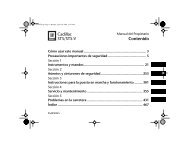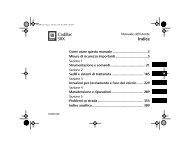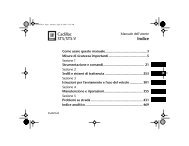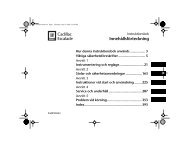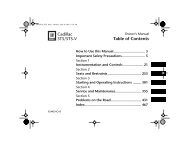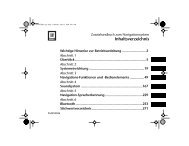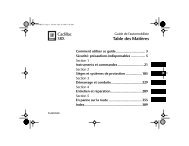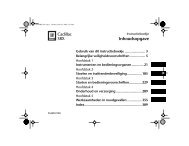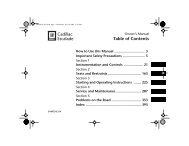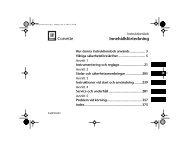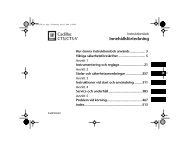Owner's Manual Cadillac BLS - IFS Europe BV
Owner's Manual Cadillac BLS - IFS Europe BV
Owner's Manual Cadillac BLS - IFS Europe BV
Create successful ePaper yourself
Turn your PDF publications into a flip-book with our unique Google optimized e-Paper software.
460_OM_MY09.book Page 130 Wednesday, April 2, 2008 10:32 AM<br />
130 Starting and driving<br />
Limp-home<br />
The engine management system has a<br />
diagnostic feature that checks a number of<br />
internal functions. If a fault is detected in the<br />
throttle valve, the engine management<br />
system will set the throttle system to the<br />
limp-home mode. This means:<br />
• idling control will be poor (uneven idling<br />
since regulated by ignition and fuel<br />
supply)<br />
• engine performance will be reduced<br />
• the cruise control will not function<br />
• the capacity of the A/C compressor will be<br />
limited.<br />
The "Engine malfunction (CHECK<br />
ENGINE)" indicator illuminates in the main<br />
instrument panel if the diagnostics function<br />
detects a fault in the engine management<br />
system. See page 63. The car should be<br />
checked by a workshop as soon as possible.<br />
We recommend that you contact an<br />
authorised <strong>Cadillac</strong> workshop.<br />
NOTICE<br />
If "Engine malfunction (CHECK<br />
ENGINE)" starts to flash (indicating that<br />
the engine is seriously misfiring and there<br />
is a risk of catalytic converter damage)<br />
release the accelerator slightly. The<br />
warning light may then either go out or<br />
shine with a steady glow. If the light continues<br />
to flash despite easing off the<br />
accelerator, you may continue to drive the<br />
car. It is however recommended that you<br />
drive the car as gently as allowed by the<br />
current traffic situation. Have the car<br />
checked at a workshop as soon as possible.<br />
We recommend that you contact an<br />
authorised <strong>Cadillac</strong> workshop.<br />
Important information<br />
concerning petrol-engined cars<br />
The catalytic converter is an emission control<br />
device incorporated in the car’s exhaust<br />
system. It consists of a metal canister with a<br />
honeycomb insert, the cells of which have<br />
walls coated in a catalytic layer (precious<br />
metal alloy).<br />
NOTICE<br />
Use only unleaded petrol. Leaded petrol<br />
is detrimental to the catalyst and oxygen<br />
sensor and will seriously impair the<br />
function of the catalytic converter.<br />
To ensure that the catalytic converter continues<br />
to function properly, and also to avoid<br />
damage to the converter and its associated<br />
components, the following points must be<br />
observed:




